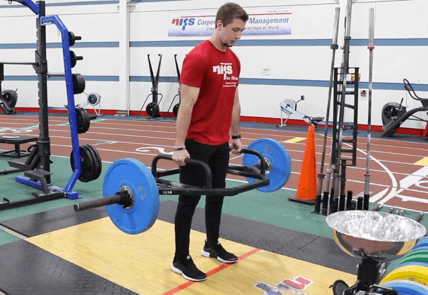 As a fitness professional I approach training and helping people from the direction that principles guide methods. The reason for this is that methods and fads will always change, but principles never do. It’s beneficial that the methods and variations of movements change from time to time, as long as the decision to change them is based on solid principles and reasoning. Variations are great, such as a change in foot position in a squat, adding load to a plank position, or varying the implement you are using during the exercise. One implement change that can pay heavy dividends (pun very much intended) is using a specialty lifting bar.
As a fitness professional I approach training and helping people from the direction that principles guide methods. The reason for this is that methods and fads will always change, but principles never do. It’s beneficial that the methods and variations of movements change from time to time, as long as the decision to change them is based on solid principles and reasoning. Variations are great, such as a change in foot position in a squat, adding load to a plank position, or varying the implement you are using during the exercise. One implement change that can pay heavy dividends (pun very much intended) is using a specialty lifting bar.
Specialty bars are not new by any means, but due to new waves of “strongman” training and the resurgence of powerlifting, the popularity of the specialty bar is constantly growing. Each different bar is designed to elicit a specific stimulus that will result in an increase in strength, stability, or performance. In fact, many bars were originally designed for the specificity of training certain sports. And although most are still widely used specifically for generating a particular training response for sports, the everyday fitness enthusiast can enjoy the benefits without having to be a pro athlete.
Bars with Benefits
Come with me as we journey through NIFS’s Bar Crawl and check out all the specialty bars that are at your disposal and some or our favorite exercises associated with each. Before we do, here’s a reminder that you need to master the basics with basic equipment before moving on to an advanced movement or piece of equipment.
Fat bar: A barbell that is thicker than a general-use bar. The typical bar has a thickness of approximately one inch, whereas a thick bar can be twice that or even more.
Benefits:
- More muscle activation in the hands, forearms, and upper arms.
- Harder contraction (experiment: flex your bicep without making a fist, then flex with a fist; notice the difference).
- Grip training no matter what.
- Greater focus on the lift/exercise.
- Bench Press
- Overhead Press
- Deadlift
Safety bar: Also referred to as a “yoke” bar, it looks like what they put on oxen back in the day. There is a three-way pad that rests on your shoulders with handles, with a curved bar shape at both ends.
Benefits:
- Great for lower-body and low-back strength and transfers nicely to the straight-bar variations.
- Loads the anterior core.
- Minimizes stress on the wrists and elbows.
- Helps in maintaining proper spinal alignment.
- Front Squat
- Back Squat
- Lunges
Log bar: Straight from the strongmen themselves, this bar simulates using a log for different movements. It looks like a log with bars on the end to add plate weight load.
Benefits:
- Cumbersome and unusual shape increases the stability need in the trunk and entire body.
- Neutral grip is safer on the wrists and shoulders and allows for a more natural movement.
- Abbreviated range of motion due to its size is safer for the joints and allows for greater load.
- Clean and Press
- Overhead Press
- Bent-over Row
Trap bar: Hexagonal in shape, this is a bar you stand in, and it is used mainly for deadlifts or floor-loaded squat motions. Top coaches like Mike Robertson and Mike Boyle almost exclusively use the trap bar for athletes for these benefits.
Benefits:
- Combines the benefits of the deadlift and the squat.
- Loaded closer to your center of gravity, making it great for beginners as well as seasoned athletes.
- More natural body position for the deadlift.
- High handles decrease the range of motion, minimizing the chance for lumbar flexion typically seen in the traditional deadlift due to the weight being out in front of the body.
- Deadlift
- Bent-over Rows
- Farmer Carry
Swiss bar: A multi-grip bar ranging from neutral to wide-grip and mixed-grip options.
Benefits:
- Lighter than a typical bar; great for beginners.
- Easy on the shoulders.
- Specific training for sports such as football.
- Range of motion similar to using dumbbells but with more load capabilities.
- Bench Press
- Overhead Press
- Bicep Curls
- Makeshift pull-up bar
Get Help from NIFS
Be sure to stop by the track desk and ask one of your highly trained instructors how a specialty bar can be used in your programming. Train smart, and train safe!
This blog was written by Tony Maloney, ACSM Certified Exercise Physiologist and Fitness Center Manager. To find out more about the NIFS bloggers, click here.

